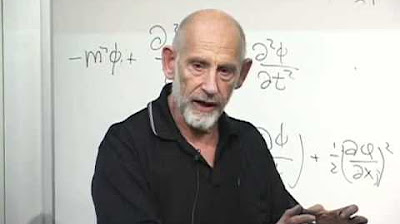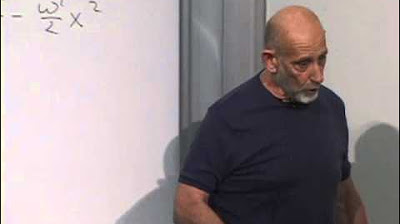Lecture 4 | String Theory and M-Theory
TLDRThe video script delves into the intricacies of string theory, focusing on the mathematical underpinnings and physical implications of closed strings. It begins with a reminder of Noether's theorem, which links symmetries to conserved quantities, and introduces the concept of canonical momentum. The lecturer then transitions to discussing closed strings, emphasizing their lack of endpoints and the parameterization by sigma, which ranges from 0 to 2π. The script explores the properties of waves on closed strings, distinguishing between right-moving and left-moving waves, and how they relate to the string's orientation. The mathematical representation of these waves using exponential functions is also covered. The lecturer further explains the energy and momentum of the string in terms of harmonic oscillators and the creation and annihilation operators associated with each mode of oscillation. The concept of level matching—a rule that requires the right-moving and left-moving energies to be equal—is introduced as a key condition for valid string states. The script concludes by contemplating the fundamental nature of strings, challenging the traditional notion of reductionism and suggesting that what is considered fundamental may change with the parameters of the theory. This perspective invites a deeper consideration of the nature of physical reality in the context of string theory and its potential unification with other theories, such as M-Theory.
Takeaways
- 📚 The lecturer begins with a reminder of Noether's theorem, which relates conserved quantities to symmetries in classical mechanics, and its significance in quantum mechanics as the generator of symmetry.
- 🌀 The canonical momentum is defined in relation to the Lagrangian of a system and is crucial for understanding the dynamics of particles in classical mechanics.
- 🔄 Noether's theorem is applied to infinitesimal transformations of coordinates, such as those involved in rotational symmetry, to derive conserved quantities like angular momentum.
- 🎓 The lecturer introduces the concept of closed strings in string theory, which are loops without endpoints, as opposed to open strings with two endpoints.
- 📐 The parameterization of a closed string is discussed, highlighting that it runs from 0 to 2π, as opposed to the parameterization of open strings.
- 🌊 The distinction between left-moving and right-moving waves on a closed string is made, with the direction determined by the increase or decrease of the parameter σ.
- 🧲 The lecturer explains that the energy of a string can be expressed as a sum of left-moving and right-moving waves, which are transparent to each other due to the linearity of the equations of motion.
- ⚙️ Each mode of oscillation on a string is associated with a harmonic oscillator, and the time dependence of these oscillators is represented by variables that are integrated into the Lagrangian of the system.
- 🚫 Level matching is introduced as a rule that states the right-moving and left-moving energies on a string must be equal for a valid string state, which is a requirement derived from the theory's requirement of invariance under reparameterization.
- ✨ The concept of massless spin-two particles, such as gravitons, is discussed in the context of closed string theory, suggesting that these particles could be fundamental to the fabric of spacetime.
- ❓ The question of whether strings are the most fundamental entities in the universe is addressed, with the lecturer suggesting that the concept of fundamental depends on the context and parameters of the theory.
Q & A
What is Noether's theorem and how does it relate to symmetries and conserved quantities?
-Noether's theorem states that for every symmetry in a physical system, there is a corresponding conserved quantity. In the context of classical mechanics, symmetries are connected to conserved quantities. In quantum mechanics, these conserved quantities are represented by operators known as the generators of symmetry.
What is the canonical momentum in classical mechanics?
-The canonical momentum, often denoted as \( p_i \), is the momentum conjugate to a given coordinate \( q \). It is defined as the partial derivative of the Lagrangian \( L \) with respect to the velocity \( \dot{q} \) of the coordinate.
How does the orientation of a closed string affect its physical properties?
-The orientation of a closed string, which is an intrinsic property referring to the directionality along the string, does not affect its physical properties. The string can be rotated in space without changing its physical characteristics, as the directionality is not tied to any specific spatial orientation.
What are the boundary conditions for a closed string?
-For a closed string, the boundary conditions are such that the coordinates at the start and end of the string's parameterization must be the same. This means that \( X(0) = X(2\pi) \) and \( Y(0) = Y(2\pi) \), ensuring the string is continuous and has no endpoints.
How do right-moving and left-moving waves on a closed string differ?
-Right-moving waves on a closed string propagate in the direction of increasing parameter \( \sigma \), while left-moving waves propagate in the direction of decreasing \( \sigma \). The distinction is not about spatial orientation but rather the direction along the string's parameterization.
What is the significance of the level-matching condition in closed string theory?
-The level-matching condition states that the total energy of right-moving and left-moving waves on a closed string must be equal. This condition is crucial for the consistency of the string theory, as it ensures that the string's state remains invariant under reparameterizations of the string's spatial extent.
How does the energy of a closed string relate to its vibrational modes?
-The energy of a closed string is related to its vibrational modes through the harmonic oscillators associated with each mode. Each mode of oscillation corresponds to a harmonic oscillator, and the energy is the sum of the energies of all these oscillators.
What are creation and annihilation operators in the context of string theory?
-Creation and annihilation operators are used to excite the vibrational modes of a string. Creation operators add energy to a mode, effectively creating a more excited state, while annihilation operators remove energy, leading to a less excited or lower energy state.
What is the physical interpretation of the ground state and the first excited states of a closed string?
-The ground state of a closed string represents the lowest energy state with no oscillations. The first excited states are obtained by applying creation operators to the ground state, which can correspond to massless particles like photons or gravitons, depending on the vibrational mode excited.
Why are the dilaton and axion particles significant in string theory?
-The dilaton and axion particles are significant because they are massless and can appear as excited states in closed string theory. The dilaton is associated with the scale invariance of string theory, while the axion is related to the quantum chromodynamics (QCD) axion and can potentially solve the strong CP problem in particle physics.
What is the role of angular momentum in determining the physical states of a closed string?
-Angular momentum is crucial in determining the physical states of a closed string as it helps classify the states into multiplets. The level-matching condition, which requires equal left-moving and right-moving energies, also implies certain constraints on the possible values of angular momentum for the string states to be physically meaningful.
Outlines
📚 Introduction to Noether's Theorem and Canonical Momentum
The first paragraph introduces the concept of Noether's theorem, which links symmetries to conserved quantities. It discusses the canonical momentum, which is the momentum associated with a coordinate in classical mechanics, and the importance of this theorem in the context of quantum mechanics, where conserved quantities become generators of symmetry.
🔄 Understanding Closed Strings and Their Parameterization
The second paragraph delves into the concept of closed strings, which are string-like objects without endpoints. It explains the parameterization of these strings using the parameter Sigma, which runs from zero to two times Pi. The paragraph also discusses the orientation of the string and how it is independent of spatial orientation.
🌊 Waves on Strings and Their Directionality
The third paragraph explores the idea of waves moving along the string, distinguishing between right-moving and left-moving waves based on the directionality with respect to the parameter Sigma. It also touches on the concept of a string being like a rubber band and how waves can propagate in both directions along it.
🌀 Harmonic Oscillators and the Energy of String Oscillations
The fourth paragraph discusses the coordinates describing the string and how they relate to the string's oscillations. It introduces the concept of harmonic oscillators and the time-dependent nature of these oscillations, which are represented by the coefficients in the expansion of the string's coordinates.
🚀 Level Matching and the Spectrum of Closed Strings
The fifth paragraph focuses on the level matching condition in string theory, which requires that the energy of right-moving and left-moving waves on a string be equal. This condition is crucial for determining the legitimate states of a string and is related to the invariance of the string's state under reparameterizations.
🧲 Magnetic Monopoles and the Concept of Fundamental Particles
The sixth paragraph shifts the discussion to magnetic monopoles and the philosophical question of what constitutes a fundamental particle. It highlights the interplay between electric and magnetic charges and how the concept of fundamental versus composite particles can change depending on the context and parameters of the theory.
🔍 The Nature of Strings and the Evolution of Theoretical Physics
The seventh paragraph concludes with a reflection on the nature of strings and the evolution of reductionism in theoretical physics. It suggests that the idea of an ultimate fundamental building block may not be applicable, as concepts of fundamental and composite can transform based on the parameters of the theory.
🎓 Transitioning to M-Theory and its Relation to String Theory
The final paragraph transitions the discussion towards M-Theory, an extension of string theory that unifies different versions of it. It sets the stage for exploring why certain dimensions are required in string theory and how M-Theory provides a broader framework that encompasses string theory.
Mindmap
Keywords
💡Canonical formalism
💡Noether's theorem
💡Closed strings
💡Harmonic oscillators
💡Level matching
💡Graviton
💡Dilaton
💡Axon
💡Reparameterization invariance
💡M-Theory
💡Quantum field theory
Highlights
Nur's theorem is introduced, which connects conserved quantities with symmetries in classical mechanics.
The canonical momentum is defined in relation to a given coordinate's time derivative.
An example of a symmetry transformation is given, illustrating how coordinates change under rotation.
The Noether charge, or generator of the transformation in quantum mechanics, is explained.
Closed strings are described as strings without ends, parameterized by an angle from 0 to 2π.
The orientation of a closed string is distinguished from its spatial orientation.
Waves on a closed string can move to the right or left, defined by the direction of increasing sigma.
The general form for the expansion of a function periodic with a period of 2π is discussed.
Harmonic oscillators are identified as the time-dependent components in the string's coordinates.
The energy of the string is expressed as the sum of left and right moving waves.
The creation and annihilation operators are associated with the excitations of the string.
The level matching condition is introduced, stating that the right-moving and left-moving energies must be equal.
The ground state of the string and its excitations are explored, leading to the prediction of massless particles.
The existence of a massless spin-two particle, possibly a graviton, is inferred from the string spectrum.
The dilaton and axion, two particles with zero angular momentum, are identified in the string spectrum.
The philosophical question of the fundamental nature of strings is addressed, emphasizing the concept of usefulness over absolute definitions.
The concept of M-Theory is introduced as a new perspective on string theory, hinting at a deeper unifying framework.
Transcripts
5.0 / 5 (0 votes)
Thanks for rating:





